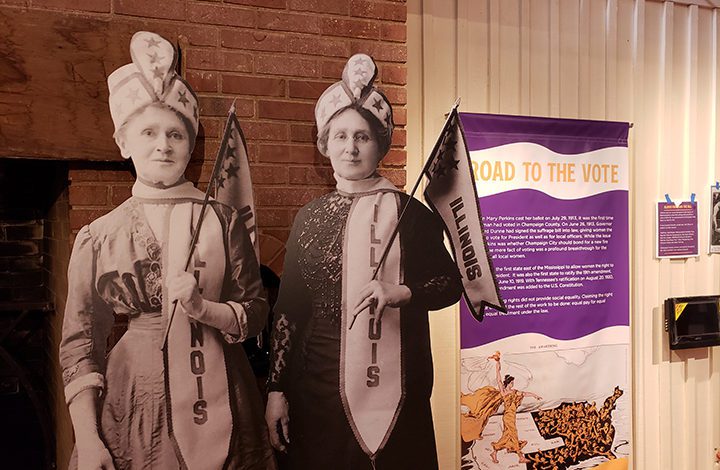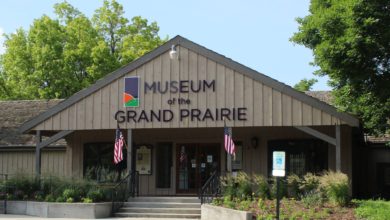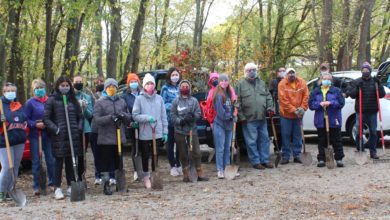Women’s Suffrage story to be told at Museum of the Grand Prairie throughout 2020

BY DANI TIETZ
dani@mahometnews.com
There are significant dates one learns during their time in American History class:
The Declaration of Independence was passed by Congress on July 4, 1776;
The United States Constitution was signed on Sept. 17, 1787;
The Abolition of the Slave Trade Act entered the statute books on March 25, 1807;
World War I ended on Nov. 11, 1918.
The dates reflect a moment in time when there was a change in the way things operated in the United States. But the story of the years before and the years after is one that is often untold.
The same holds true for Aug. 18, 1920. The 19th Amendment to the Constitution of the United States was ratified and women were granted the right to vote; a right their male counterparts had enjoyed for more than a century.
The century prior to 1920 and the century after 1920 are full of rich stories about how the Women’s Suffrage Movement came to be and how, in some ways, women continue to fight for their rights even today.
On March 7, 2020, the Champaign County Forest Preserve District’s Museum of the Grand Prairie will open its annual exhibit, “How Long Must Women Wait: Women’s Suffrage and Women’s Rights in Champaign County?” to tell the unknown stories of how advocates in Champaign County helped propel the national movement for equal rights and responsibilities as American citizens.
“It’s a national movement but it’s also a very local movement,” Museum and Education Department Director Barbara Oehlschlaeger-Garvey said.
The Museum’s exhibit follows stories of women who were working towards their right to own land and to vote, among other issues from 1850 to the current day.
“There were ladies that were forming women’s clubs in the late 19th century, names you know like Julia Burnham and Mary Busey, who were strong supporters of women’s suffrage. Those women also realized that they had an obligation to make positive social change.
“That’s why they were interested in creating the first hospital in the county and the first library; actually both Urbana and Champaign’s libraries were founded by ladies who were strong in the suffrage movement.”
Oehlschlaeger-Garvey’s team collected information from Champaign County’s Jane Patton’s estate to tell the story of a widowed woman becoming a property owner — something she could not do a decade prior to her husband’s passing.
“We don’t know whether she was involved in the (women’s suffrage) movement at all or not, but what we do know is that when she moved here in the 1850’s they built a log cabin, they lived at the edge of the prairie and they had 8 or 10 kids,” Oehlschlaeger-Garvey said.
“She worked really hard. When her husband died in 1880, he had a lot of debt. She paid off all the debt. And by the time she passed away, she acquired 2500 acres. She was an exceedingly successful lady.
“It is reported that she was present at 102 births. So she was also, you know, a community helper.
Oehlschlaeger-Garvey added that there are a lot of women’s stories like Patton’s that can be found, both at the Museum and in local papers and documents.
“We talked about her as the typical woman’s life; somebody who made a difference, but didn’t get noticed,” she said.
Talks of women’s voting rights made it to a conversation in 1870 when the Illinois constitution was up for amending. The measure failed.
Women were, though, granted the opportunity to run for any school office not created by the Illinois Constitution by 1873.
By 1891, women were given the right to vote for school officers. Women who voted were given a separate ballot and ballot box in which to vote.
While women are still fighting for their voice and rights, in some ways, Oehlschlaeger-Garvey said that many of the conversations that started on the national level could be heard in Champaign County, too.
“Susan B. Anthony, Sojourner Truth and Frederick Douglass all came to the area all speaking about the rights of women and minorities,” she said.
The conversation about women’s rights began to spark a small, but potent anti-suffragette movement in the early 1900’s.
“There were a lot of cartoons and things that mocked women for wanting to vote,” Oehlschlaeger-Garvey said. “Some people felt threatened.”
According to Oehlschlaeger-Garvey, that group was small, though.
“It’s actually kind of more hard to find people who are against (women’s rights),” she said.
Women took the first steps in using the American right to free speech by marching through Washington, D.C. in 1913 to “march in a spirit of protest against the present political organization of society, from which women are excluded,” the day before President Woodrow Wilson’s inauguration.
The Museum’s exhibit showcases Champaign’s Lillie Belle Sale, Eliza Vincent and Edith Dobbins, who attended the march.
The procession organized by the suffragists Alice Paul and Lucy Burns for the National American Woman Suffrage Association (NAWSA), sought to create a visible display of support for women’s rights.
“They invited contingents from every state, and from all over the world to participate in this parade,” Oehlschlaeger-Garvey said. “And the estimates are wonky: some people say it was 5,000, some people say it was 10,000 people.
“It kind of took the power out of all the inauguration festivities.”
When Sale, Vincent and Dobbins returned home, they helped form the Twin City Equal Suffrage League, which eventually became the League of Women Voters.
Oehlschlaeger-Garvey said some of the long call for change echos what some continue to fight for today.
“People were involved and it mattered to them,” she said. “Now, it’s just that we’re in the middle of it, so we don’t see it.”
By June 26, 1913, Gov. Edward Dunne signed the suffrage bill into law, giving Illinois women the right to vote for President.
While states west of the Mississippi River had granted women the right to vote prior, Illinois became the first state east of the Mississippi to allow women (1,600,000) to vote, doubling the number of voters in the United States, according to Oehlschlaeger-Garvey.
“So by allowing Illinois women to vote, he doubled the electorate,” she said.
While women in Illinois could vote for presidential electors, mayor, aldermen and most other local offices, they could not vote for governor, state representatives or members of Congress because that would have meant that the state had to ratify their constitution.
Many women, for the first time since getting married, were required to use their “Christian name.
“Women didn’t really have personalities, outside of their husbands until this point, but then they needed to know what their actual name was to identify them as people,” Oehlschlaeger-Garvey said.
Women still had to vote at a separate ballot box, though.
Oehlschlaeger-Garvey said women became increasingly disheartened that they were playing vital roles in ensuring the country continued to thrive even when their husbands and sons were fighting in WWI, but were not able to vote.
“They were not able to vote about things that are concerning people who are making decisions about the war,” she said. “So that was one big push that probably helped suffrage.”
Frustrated with the slow-moving process at the National level, the National Woman’s Party’s (NWP) Alice Paul organized a group to protest at the gates of the President’s house on Jan. 30, 1917.
The group became known as the “Silent Sentinels,” as they stood at their posts for almost three years.
The group sought to influence Wilson’s opinion, seeking his endorsement to sway members of Congress from the Democratic Party to vote for the amendment’s passage.
Instead, the group became a nuisance to Wilson, and were later arrested on charges of obstructing traffic.
The women continued to take their stand at the White House gates and later in Lafayette Square until June 4, 1919 when the 19th Amendment to the United States Constitution was passed, both by the House of Representatives and the Senate.
The Museum of the Grand Prairie’s exhibit also tells the story of prohibition, which many suffragette supporters were in favor of. Prohibition actually went into effect before Women’s Suffrage on Jan. 17, 1920.
“It’s because all that movement was going in the same direction,” Oehlschlaeger-Garvey said. “There were women that were pushing toward the same thing.”
The Museum staff knows that that movement did not stop with the passing of equal rights and responsibilities in the 1920’s. The exhibit also showcases the women’s liberation movement of the 1970’s, the continued fight for equal pay and the Women’s March on Washington D.C.
The Museum’s March 7 opening will begin with a short welcoming reception and exhibit preview from museum staff at 1:30 p.m.
Beginning at 2 p.m., students from Eastern Illinois University’s Women’s, Gender, and Sexuality Studies program will provide short first-person interpretations of a 19th century suffrage supporter, a female Irish pirate and the first woman who ran for Congress.
The Champaign County Forest Preserve will continue to celebrate women throughout 2020 with their Speakers Series and their Summer Concert Series, which will feature only female artists.
Oehlschlaeger-Garvey said that like the book “The Heartland: An American History” by Kristin L. Hoganson suggests, “there’s this perception that the Midwest have always been like nowheresville, but really it’s always been like that part of the whole big national engine.”
Saturday, May 30
CASTING A HISTORIC VOTE: SUFFRAGE IN ILLINOIS
Museum of the Grand Prairie, Lake of the Woods Forest Preserve, 2 p.m.
Lecture presented by Jeanne Schultz-Angel, historian and Director of Learning Experiences at Naper
Settlement in Naperville, Illinois
Prior to 1920, women were denied the vote in the majority of elections in the United States. The struggle for
enfranchisement began with the birth of our nation and was strategized differently in our local, state, and federal
elections. Despite what people today believe to be a straightforward goal, the path to women’s suffrage was
infused with sexism and racism and triggered a fear of feminism whose roots are still seen today.
Sunday, June 7
HISTORY BROUGHT TO LIFE: ELIZABETH CADY STANTON
Museum of the Grand Prairie, Lake of the Woods Forest Preserve, 2 p.m.
First-person Interpretation presented by Laura Keyes, historian, author, and professional actor, will
portray Elizabeth Cady Stanton
Elizabeth Cady Stanton fought for equal rights for women for over fifty years, and upon her death in 1902 she
left behind a legacy of her crusade for female equality and myriad writings that would inspire feminists for over
a century to come. Hear from Mrs. Stanton in 1866, when the Civil War was over, but the battle for Women’s
Suffrage was just beginning. Join us for this engaging first
Sunday, July 19
SONGS AND STORIES FROM THE WOMEN’S MOVEMENT IN CHAMPAIGN-URBANA, 1973-
1983
Museum of the Grand Prairie, Lake of the Woods Forest Preserve, 2 p.m.
Musical presentation provided by Kristin Lems, singer-songwriter and founder of the National Women’s
Music Festival
Champaign-Urbana was the home of great activism and activity on behalf of women’s rights in the decade
between 1973-1983. There were ERA rallies, a rape crisis center, a women’s escort service to take women home
safely after parties and events, and groups from the Abortion Rights Coalition to Gay Illini to Housewives for
ERA. Kristin Lems will share songs and stories from those days along with precious (to her!) artifacts including
t-shirts, posters, and buttons.
Sunday, August 16
AN AFTERNOON WITH SUFFRAGISTS
Museum of the Grand Prairie, Lake of the Woods Forest Preserve, 2 p.m.
First-person Interpretation presented by Volunteer docents from the Champaign-Urbana Alliance
Chapter of the Daughters of the American Revolution
Did you know that on August 18, 1920, the 19th amendment was officially ratified allowing women the basic
human right to vote? Join us and help celebrate this month’s historic 100-year anniversary! History will come to
life during this one-act reading play portraying the famous suffragists Susan B. Anthony, Alice Paul, and Inez
Mulholland.



